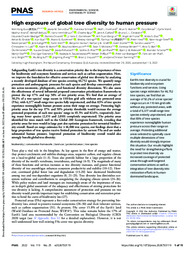High exposure of global tree diversity to human pressure.
High exposure of global tree diversity to human pressure.
Author(s): GUO, W.-Y.; SERRA-DIAZE, J. M.; SCHRODTF, F.; EISERHARDT, W. L.; MAITNER, B. S.; MEROW, C.; VIOLLEJ, C.; ANAND, M.; BELLUAU, M.; BRUUN, H. H.; BYUN, C.; CATFORD, J. A.; CERABOLINI, B. E. L.; CHACÓN-MADRIGAL, E.; CICCARELLI, D.; CORNELISSEN, J. H. C.; DANG-LE, A. T.; FRUTOS, A. de; DIAS, A. S.; GIROLDO, A. B.; GUO, K.; GUTIÉRREZ, A. G.; HATTINGH, W.; HE, T.; HIETZ, P.; HOUGH-SNEE, N.; JANSEN, S.; KATTGE, J.; KLEIN, T.; KOMAC, B.; KRAFT, N. J. B.; KRAMER, K.; LAVOREL, S.; LUSK, C. H.; MARTIN, A. R.; MENCUCCINI, M.; MICHALETZ, S. T.; MINDENT, V.; MORI, A. S.; NIINEMETS, Ü.; ONODA, Y.; PEÑUELAS, J.; PILLAR, V. D.; PISEK, J.; ROBROEK, B. J. M.; SCHAMP, B.; SLOT, M.; SOSINSKI JUNIOR, E. E.; SOUDZILOVSKAIA, N. A.; THIFFAULT, N.; VAN BODEGOM, P.; VAN DER PLAS, F.; WRIGHT, I. J.; XU, W.-B.; ZHENG, J.; ENQUIST, B. J.; SVENNING, J.-C.
Summary: Safeguarding Earth?s tree diversity is a conservation priority due to the importance of trees for biodiversity and ecosystem functions and services such as carbon sequestration. Here, we improve the foundation for effective conservation of global tree diversity by analyzing a recently developed database of tree species covering 46,752 species. We quantify range protection and anthropogenic pressures for each species and develop conservation priorities across taxonomic, phylogenetic, and functional diversity dimensions. We also assess the effectiveness of several influential proposed conservation prioritization frameworks to protect the top 17% and top 50% of tree priority areas. We find that an average of 50.2% of a tree species? range occurs in 110-km grid cells without any protected areas (PAs), with 6,377 small-range tree species fully unprotected, and that 83% of tree species experience nonnegligible human pressure across their range on average. Protecting highpriority areas for the top 17% and 50% priority thresholds would increase the average protected proportion of each tree species? range to 65.5% and 82.6%, respectively, leaving many fewer species (2,151 and 2,010) completely unprotected. The priority areas identified for trees match well to the Global 200 Ecoregions framework, revealing that priority areas for trees would in large part also optimize protection for terrestrial biodiversity overall. Based on range estimates for >46,000 tree species, our findings show that a large proportion of tree species receive limited protection by current PAs and are under substantial human pressure. Improved protection of biodiversity overall would also strongly benefit global tree diversity.
Publication year: 2022
Types of publication: Journal article
Keywords: Biodiversidade, Conservação, Área protegida, Árvore
Observation
Some of Embrapa's publications are published as ePub files. To read them, use or download one of the following free software options to your computer or mobile device. Android: Google Play Books; IOS: iBooks; Windows and Linux: Calibre.
Access other publications
Access the Agricultural Research Database (BDPA) to consult Embrapa's full library collection and records.
Visit Embrapa Bookstore to purchase books and other publications sold by Embrapa.

